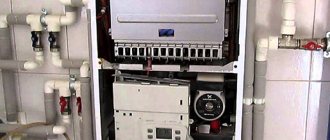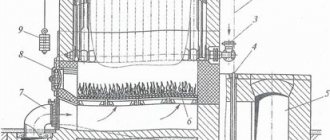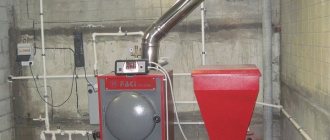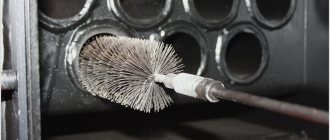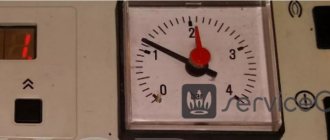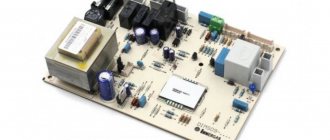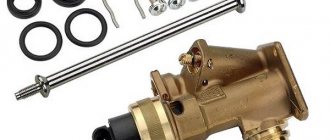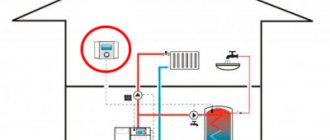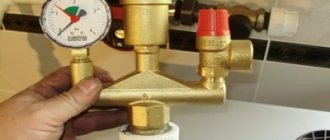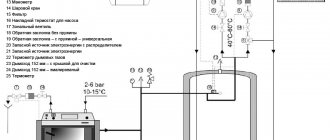Repair and decoration
05/29/2018 Anastasia Prozheva
A feature of the state of energy today is that at heating plants the number of shutdowns and downtime of boilers has increased, this is due to changes in the regime of energy consumption and heat supply. Equipment is reserved for an indefinite period. When the boiler is stopped, the pressure of the environment drops to atmospheric pressure, there is a possibility of moisture and air getting into it, as a result the boilers undergo corrosion, which is considered dangerous, since there is a possibility of damage to all heating equipment, including pipelines. Therefore, at the moment, the issue of conservation is especially relevant, and the development of technologies in this regard is progressing.
Scheme of a solid fuel boiler.
Thanks to protection against corrosion formed during downtime, the operating condition of the equipment is maintained, the costs of its repair and restoration are reduced, the technical and economic indicators of the operation of thermal power plants are maintained, and production costs are also reduced.
There are several ways to preserve boilers:
- gas preservation method;
- wet preservation method;
- method of applying excess pressure;
- dry preservation method.
A daily downtime of an unpreserved boiler will lead to rust of equipment in the circuit of up to 50 kg of iron oxide. When stopping water heating boilers for a period of 15 hours or drum boilers for up to 1 day, it is recommended to carry out preservation using the overpressure method, for a short period (5-6 days) - the dry preservation method. The choice of a suitable method for eliminating oxygen corrosion is made taking into account the parameters and power of the boilers, and their specific operation.
To prevent standing corrosion of the metal of boiler heating surfaces during major and current repairs, only conservation methods are applicable that make it possible to create a protective film on the metal surface that retains its properties for 1-2 months after draining the preservative solution, since emptying and depressurization of the circuit in this case inevitable.
Instructions for preserving steam and hot water boilers with gas
Gas boiler diagram.
This method is intended for preserving boilers during downtime by reducing the pressure to atmospheric pressure. It is used for the preservation of steam and hot water boilers. During the proposed conservation, the boiler is emptied of water and filled with gas (for example, nitrogen), after which excess pressure is maintained inside the boiler, at the same time, before gas is supplied, it is filled with deaerated water.
The method of preserving a steam boiler involves filling the boiler with gas at an excess pressure in the heating surface of 2-5 kg/cm² while simultaneously displacing water in the drum. In this case, air cannot get inside. According to this scheme, gas (nitrogen) is supplied to the outlet manifolds of the superheater and into the drum. The low excess pressure in the boiler is due to nitrogen consumption.
This method cannot be used when preserving boilers in which the pressure has dropped to atmospheric pressure after shutdown and the water has been drained. There are cases of emergency shutdown of the boiler. During repairs, it is completely emptied, so air gets inside. The specific gravity of nitrogen and air does not differ significantly, therefore, if the boiler is filled with air, it is impossible to replace it with nitrogen. In all areas where air is present and where humidity exceeds 40%, the metal of the equipment will be susceptible to oxygen corrosion.
The small difference in specific gravity is not the only reason. Displacement of air from the boiler and uniform distribution of nitrogen throughout it is also impossible due to the lack of hydraulic conditions, which are caused by the nitrogen supply system (via the outlet manifolds of the superheater and drum). Also in the boiler there are so-called undrained areas that are impossible to fill. Consequently, this method is applicable only after the boiler is operating under load while maintaining excess pressure in it. This is the disadvantage of such a technical solution.
Related article: Chocolate living room - photo of an unusual combination in the living room interior
The objective of the boiler preservation method with gas is to increase the reliability and efficiency of boilers that are put into reserve by completely filling the steam-water path with gas, regardless of the shutdown mode. The described preservation method is illustrated by the diagram (image 1). Boiler conservation diagram indicating boiler equipment:
Steam boiler diagram.
- Drum.
- Air balloons.
- Superheater.
- Air balloons.
- Capacitor.
- Air balloons.
- Superheater outlet manifold.
- Remote cyclone.
- Air balloons.
- Screens of boiler circulation panels.
- Economizer.
- Drainage of the lower points of the boiler.
- Superheater outlet chamber vents.
- Nitrogen supply line with valve.
- Air exhaust line from vents with valve.
- Water drainage and supply line with valve.
List of necessary tools, devices, devices:
- Pressure gauges are U-shaped.
- Gas analyzer.
- Set of wrenches.
- Combination pliers.
- Screwdrivers.
- Files.
- Ladder.
- Bucket.
- Solid oil.
- Paronite gaskets.
- Plugs, bolts, nuts, washers.
- First aid supplies and medications.
- Fire extinguisher.
The process of preserving a boiler with gas is carried out as follows (an example of preserving a steam drum boiler is given):
Diagrams of separation devices in the boiler drum.
The boiler is emptied of water after it is stopped by opening all its lower points. After emptying, in some places a steam-air mixture remains, containing oxygen, which causes corrosion of the metal of the boiler equipment. In order to displace the steam-air mixture, all boiler elements (1, 3, 5, 7, 8, 10, 11) are filled with deaerated water. Filling occurs through the lower points (12). Complete filling is controlled by valve (15), after which nitrogen is closed and supplied through valve (14), then through air vents (9, 2, 6, 4, 13).
When supplying nitrogen to the boiler, it is necessary to open the drains of the lower points of all its components. Next, the water is displaced and the boiler is filled with nitrogen. The nitrogen pressure in the boiler is adjusted at the supply line 14 and (if necessary) at the outlet line 16. After the water is completely displaced and the boiler is filled with nitrogen, the excess pressure necessary for preservation is established (25-100 mm water column). Despite the presence of a small amount of deaerated water in some areas of the boiler, the metal of the equipment is not subject to corrosion, this has been proven by research.
Consequently, the proposed method significantly increases the reliability of preservation due to the absolute removal of air from the boiler, filling it with deaerated water and nitrogen with parallel displacement of water.
Instructions for conservation of heating networks
In the summer, you need to remove the coolant from it, or, more simply, drain the water. In an unfilled system, the quality of pipes and batteries, the reliability of connections and the degree of contamination of the system are checked.
In warm weather, it is easier to eliminate all possible faults in order to avoid various unnecessary problems in winter, when uninterrupted operation of the heating system is necessary.
- First of all, you need to inspect the system in detail for leaks. If there is a leak in a heating pipe, it can be identified by a rusty tint on the surface of the radiator or pipe; there may also be traces of moisture dripping onto the floor, usually they are localized at the joints of the pipes.
- As soon as you can localize the leak, you need to reconnect the pipe fragments here or seal the radiator sections so that the system does not depressurize in the winter and big problems do not start.
- The water in the system needs to be replaced annually, since it is usually untreated and needs to be cleaned of impurities that can contaminate the flow due to corrosion processes in the pipeline, as well as waste from the boiler.
After draining the water, flush the system until the water supplied to the inlet becomes light and clean, once you have achieved this effect, you can fill the system.
The boiler also needs to be inspected annually, be sure to inspect the heating elements in them, if necessary, they need to be cleaned, check the contacts in the starting box, they must be polished, loosen the wire connections and tighten them again so that there are no poorly functioning connections.
If you have a gas boiler, then it is better to have the maintenance carried out by specialists who installed it and are certified to work with gas appliances. They must check the quality of the connections on the communications; at home this can be done with soap foam if you apply it to the area where the pipes are connected; you also need to look at the chimney, burner and the functioning of the ignition system.
Even if the boiler is out of warranty, you cannot disconnect the gas communications and clean the burner yourself. If you are carrying out maintenance on a solid fuel boiler, then you need to clean the firebox, pyrolysis chamber and chimney.
All this work can be carried out using a special metal brush; you should be left with a minimum of soot and deposits so that the system is as clean as possible. Of course, the heating does not work in the summer, but it is necessary to prepare for winter.
- There is also chemical flushing of heating systems; it can not be done every year, but depending on how high-quality water you use.
- If you use a specially purified liquid, then you don’t have to do it at all, but if you use ordinary water, then during operation of the system you will form scale, which can interfere with the circulation of water and reduce the efficiency of the system, that is, chemical flushing is necessary. To do this, you will need a special pump; you can buy or rent it.
- The chemical composition must be selected individually, it depends on the characteristics of the boiler and pipes, it must be selected by specialists. Flushing the system should last about an hour, after which thoroughly rinse the remaining liquid from the pipeline; this can be done using plain water.
After washing, small leaks will remain in it, which were previously clogged with scale or corrosive chips; after washing, test the system with increased water pressure, that is, you need to carry out pressure testing.
The system must be put under pressure up to 0.6 MPa, the pressure pumped by the pump must be maintained for at least 20 minutes, during which time the condition of the pipes is checked and the stability of the pressure sensor readings in the system is analyzed. If the readings have changed by less than 0.01 MPa, then the system is operating normally and is sealed.
In most systems, heating occurs by heating water, this is the main coolant, it must be as clean as possible, ordinary tap water is hard, it contains many impurities, so it accelerates corrosion in pipes and heating radiators.
It is always better to use the most purified water possible, rainwater is a good option, filtered melt water is also suitable, sometimes boiled water or water softened with special inhibitors is used.
If you take this work as responsibly as possible and entrust it to professional specialists, then no matter the winter temperature, your home will be warm and cozy.
Work schedule, frequency of scheduled and partial inspections of utilities and technical devices in the serviced housing stock
SCHEDULE
performance of work, frequency of planned and partial inspections of utilities and technical devices in the serviced housing stock.
| No. | Name of engineering communications and technical devices | Career profession | Periodicity |
| 1 | 2 | 3 | 4 |
| 1. | |||
| -preservation and re-preservation of central heating systems | plumber | 2 times per year | |
| -adjustment of three-way and plug valves, valves and gate valves, their repair | plumber | 2 times a year, as needed | |
| -adjustment and packing of oil seals | plumber | as needed | |
| -squeezing compaction | plumber | as needed | |
| - descaling of shut-off equipment, repairs | plumber | 1 time per year | |
| -testing of central heating systems | plumber | 1 time per year | |
| -flushing the central heating system | plumber | 1 time per year | |
| - shutting off radiators when they leak | plumber | as needed | |
| -cleaning and repair of mud traps | plumber-welder | 1 time per year | |
| - draining water and filling the heating system with water | plumber | 2 times per year | |
| -elimination of air jams in radiators and risers | plumber | as needed | |
| -preparing the heating unit for the heating season | plumber | 1 time per year | |
| 2. | |||
| - changing gaskets and stuffing seals in water supply and valve taps in the elevator unit premises | plumber | as needed | |
| -squeezing compaction | locksmith plumber | as needed | |
| -temporary sealing of fistulas and cracks in internal pipelines and risers | plumber | upon detection | |
| -preservation and re-preservation of the irrigation system | plumber | 2 times per year | |
| - cleaning drainage systems | plumber | 2 times per year | |
| -checking the serviceability of the sewer hood | plumber | 2 times per year | |
| -cleaning sewer pipes | plumber | 2 times per year | |
| -ventilation of sewer wells | plumber | 2 times per year | |
| -elimination of leaks of sanitary fixtures in the elevator unit | plumber | upon detection | |
| 3. | |||
| -inspection of lighting in common areas and replacement of burnt-out light bulbs and starters | electrician | 2 times a month | |
| -strengthening lampshades and weakened areas of external electrical wiring | electrician | as needed | |
| -cleaning terminals and connections in group panels and distribution cabinets | electrician | 2 times per year | |
| -checking the grounding of electrical cables | electrician | 2 times per year | |
| -measurements of pipeline insulation resistance | electrician | 2 times per year | |
| -checking equipment grounding | electrician | 2 times per year | |
| 4. | - cleaning the roof and fire escape from snow and ice | as needed |
Testing of heat supply systems
Operation of MKD > Autumn-winter period > Methodological recommendations for preparation for autumn winter season
Methodological recommendations on the procedure for preparing housing and communal services facilities for the heating period
2.3.1. Testing of heat supply systems.
Testing of heat supply systems in operation (test firebox) is carried out in order to check the readiness of heat supply sources, heating networks and reserve fuel facilities by the beginning of the heating period and to eliminate identified defects.
Trial fires are carried out in accordance with schedules developed by heat supply organizations, agreed upon with consumers of utilities and suppliers of fuel and energy resources, and approved by the local government.
Schedules are approved before September 1. Test fires are carried out according to a special program developed by the heat supply organization and agreed upon with local governments.
During the testing of heat supply systems, the preservative is replaced and the heat supply and heating systems are put under pressure.
The trial fire is carried out within 72 hours, and the following must be ensured:
When filling the heating systems of buildings, the air collectors at the highest points must be open until the air stops escaping and water appears. It is necessary to ensure constant monitoring of air collectors. After creating circulation, releasing air from the air collectors should be repeated every 2 to 3 hours until it is completely removed.
During the period of trial fires, heat supply organizations monitor the operation of heating networks and heat generating installations, conduct walk-throughs and inspections in order to identify possible defects and take timely measures to eliminate malfunctions and normalize heat supply.
Management organizations monitor the heating of risers and heating devices, the parameters of the coolant at the entrance to the building and the control unit.
To analyze the operation of heat supply sources and heating networks, consumers of thermal energy 24 hours and 48 hours after the start-up of the heat source provide information to the heat supply organization about the parameters of the coolant at agreed control points.
Based on the results of trial fires, reports are drawn up indicating the addresses of buildings that underwent trial heating and compiling a list of identified deficiencies that must be eliminated before the start of the heating period. Heat supply organizations send reports of trial fires to the administrations of municipalities, which form and send consolidated registers of acts of trial fires to the Region by the beginning of the heating period in accordance with the approved forms.
The order (instruction) of the head of the utility organization to organize the operation of utility facilities and systems during the heating season includes:
Instructions for the wet method of preservation of hot water and steam boilers
Air duct operation diagram.
The boiler is filled with preservative solutions, which create a layer on the metal that retains its properties throughout the entire time the steam generator is inactive. An alkali solution is added to the water with which the steam generator is filled, observing the proportions: 2-3 kg of sodium hydroxide and 5-10 kg of sodium phosphate per 1 l³ of water with the addition of 1 kg of ammonia hydrate or a 10% solution of hydrazine hydrate. This solution provides a concentration of 200 mg/kg NzH in water and is added using a plunger pump. Reactivation of the boiler and its lighting after this method of preservation takes place quite quickly. To prevent the occurrence of corrosion, use a special protective solution that contains caustic soda. The use of soda ash is also practiced, but this is undesirable, as there is a risk of local corrosion.
Article on the topic: Where to start renovating a bathroom: photo of the sequence of work
Using the wet preservation method, the boiler is filled with a protective solution, which ensures absolute resistance to rust, even if the liquid is saturated with oxygen. When using the proposed conservation method, it is possible to determine the permissible duration without loss of mine workings; determine the timing of drainage, repair of support, ventilation, lifting complex and other equipment with the implementation of other reparative measures.
Wet method for heating preservation
The wet method is suitable for preserving boilers and the heating system as a whole. The method is to fill the circuit with a special liquid that will prevent the metal from rusting. If the house is not heated at all and there is a risk of freezing, then only antifreeze (antifreeze liquids based on propylene glycol) can be used as a preservation liquid. Concentrates do not freeze even at -60, but they thicken strongly. They can be diluted to the required consistency, thereby regulating the minimum operating temperature. The disadvantage of antifreeze is that they are expensive, dry out the rubber, have a high degree of fluidity, and turn into acid when overheated.
If you do not plan to use the Buderus gas boiler for several months, then it needs to be mothballed.
The same applies to Buderus solid fuel boilers. According to reviews, this significantly prolongs their life.
If you need to preserve the boiler and there is no risk that the liquid in it will freeze, then in addition to antifreeze, you can use water with added sodium sulfate. Its concentration must be at least 10 g/l. After this, the liquid is heated to remove air from it and all pipes are clogged. The liquid is pumped using a pressure test pump. They are different: manual, automatic, household and professional. We have already written about how to fill the heating system.
Wet preservation technology
When carrying out wet conservation of the boiler, you need to ensure that its surface and masonry are dry, and close all hatches tightly. Monitor the concentration of the solution (sodium sulfate content should be at least 50 mg/l). The use of the wet preservation method when carrying out repair work or in the presence of leaks in the boiler is unacceptable, since maintaining tightness is the main condition. If steam leakage is unacceptable with the dry and gas preservation method, then with the wet method it is not so dangerous.
Diagram of a double-turn superheater.
If it is necessary to stop the boiler for a short period, use a simple wet preservation method, filling the boiler and steam heater with deaerated water while maintaining excess pressure. If the pressure in the boiler drops to 0 after stopping it, filling with deaerated water is no longer effective. Then you need to boil the boiler water with the vents open, this is done to remove oxygen. After boiling, if the residual boiler pressure is not lower than 0.5 MPa, preservation can be carried out. This method is used only when the oxygen content in deaerated water is low. If the oxygen content exceeds the permissible value, corrosion of the superheater metal may occur.
Boilers that are switched to reserve immediately after operation can be subjected to the wet preservation method without opening the drums and collectors.
Ammonia in gaseous form can be added to the feed water. A protective film is formed on the surface of the metal, protecting it from corrosion.
In order to prevent the occurrence of corrosion in boilers that have been in reserve for a long time, the wet preservation method is used, maintaining an excess pressure of a nitrogen blanket above the liquid in the boiler, eliminating the possibility of air entering the boiler. In contrast to dry conservation, in which drainage agents operate, drainage from the mine is ensured, and boiler equipment is maintained in a condition suitable for use when necessary. At the time of conservation, write-off of mineral reserves is not permitted.
Method of preservation by creating excess pressure
Boiler valve connection diagram.
The instructions for boiler preservation technology by creating excess pressure are applicable regardless of the heating surface of the boiler. Other methods using water and special solutions are not able to protect intermediate superheaters of boilers from corrosion, since certain difficulties arise during filling and cleaning. To protect superheaters, preservation by vacuum drying using ammonia gas or filling with nitrogen is used, regardless of downtime. As for the metal of screen pipes and other parts of the steam-water path of drum boilers, they are not 100% protected to the same extent.
The proposed preservation technology is suitable for both steam and hot water boilers. The principle of this method is to maintain a pressure above atmospheric pressure in the boiler, which will prevent oxygen from entering it, and is used for boilers of any type of pressure. To maintain excess pressure in the boiler, it is filled with deaerated water. This method is used when there is a need to put the boiler into reserve or carry out repair work not related to activities on the heating surface, for a total period of up to 10 days.
Related article: How to choose tulle for your window - designer tips
The implementation of the method of maintaining excess pressure in stopped hot water or steam boilers is possible in several ways:
- When boilers are idle for more than 10 days, preservation by dry or wet methods is applicable (determined by the presence of certain reagents, cushioning materials, etc.).
- During long periods of inactivity in winter and in the absence of heating, boilers are preserved using the dry method; The use of the wet preservation method in these conditions is unacceptable.
The choice of one method or another depends on the operating mode of the boiler room, the total number of backup and operating boilers, etc.
Dry method of preserving boilers
Boiler outlet diagram.
The boiler is released from water at a pressure above atmospheric pressure after emptying due to the heat accumulated by the metal, lining and insulation while maintaining the boiler temperature above the atmospheric pressure temperature. At the same time, the internal surfaces of the drum, collectors and pipes are dried.
Dry shutdown is applicable to boilers with any pressure, but provided that they do not have rolling connections between the pipes and the drum. It is carried out during a planned shutdown in reserve or for a period of equipment repair work for a period of no more than 30 days, as well as during an emergency shutdown. In order to prevent moisture from entering the boiler during downtime, you need to ensure that it is disconnected from the water and steam pipelines under pressure. The following must be tightly closed: plug installations, shut-off valves, inspection valves.
Water is displaced at pressure levels of 0.8-1.0 MPa after the boiler has been stopped and cooled naturally. The intermediate superheater is evaporated onto a heat exchanger. Upon completion of drainage and drying, the valves and valves of the boiler steam-water circuit, the manholes and gates of the firebox and flue must be closed, only the inspection valve remains open, and if necessary, plugs are installed.
During the conservation process, after the boiler has completely cooled down, it is necessary to periodically monitor the entry of water or steam into the boiler. Such control is carried out by probing spaces where they are likely to fall into the area of shut-off valves, opening drains at the lower points of collectors and pipelines, and valves at sampling points for a short period.
If it is detected that water has entered the boiler, the necessary measures must be taken. After this, the boiler must be kindled and the pressure in it raised to 1.5-2.0 MPa. The specified pressure is maintained for several hours, and then nitrogen is produced again. If moisture ingress cannot be eliminated, they resort to a preservation method by maintaining excess pressure in the boiler. A similar method is also used if, during a boiler shutdown, equipment repair work was carried out on heating surfaces and the need for pressure testing arose.
Preservation methods for boilers and tank equipment
If the boiler is stopped for a long time, it must be mothballed. When preserving boilers, you must follow the manufacturer's instructions for installation and operation.
To protect boilers from corrosion, dry, wet and gas preservation methods are used, as well as, in some cases, preservation using the overpressure method.
The dry preservation method is used when the boiler is stopped for a long time and when it is impossible to heat the boiler room in winter. Its essence lies in the fact that after removing water from the boiler, superheater and economizer and cleaning the heating surfaces, the boiler is dried by passing hot air (thorough ventilation) or by lighting a small fire in the firebox. In this case, the safety valve must be open to remove water vapor from the drum and boiler pipes. If a superheater is installed, the drain valve on the superheated steam chamber must be opened to remove any remaining water. After drying is completed, pre-prepared iron trays with quicklime CaO or silica gel (0.5-1.0 kg CaC12, 2-3 kg CaO or 1.0-1.5 kg silica gel per 1 m3) are placed through open holes in the drums boiler volume). The openings of the drum are tightly closed and all fittings are covered. When stopping the boiler for more than 1 year, it is recommended to remove all fittings and install plugs on the fittings. In the future, the condition of the reagents must be checked at least once a month, and then every 2 months, depending on the results of the check, it must be replaced. It is recommended to periodically monitor the condition of the lining and, if necessary, dry it.
Wet method. Wet preservation of boilers is used when there is no danger of water freezing in them. Its essence lies in the fact that the boiler is completely filled with water (condensate) with high alkalinity (caustic soda content 2-10 kg/m3 or triphosphate 5-20 kg/m3). Then the solution is heated to boiling point to remove air and dissolved gases from it and the boiler is tightly closed. The use of an alkaline solution ensures, at a uniform concentration, sufficient stability of the protective film on the metal surface.
Gas method . With the gas preservation method, water is drained from the cooled boiler and the internal heating surface is thoroughly cleaned of scale. After this, the boiler is filled with ammonia gas through the air vent and a pressure of about 0.013 MPa (0.13 kgf/cm2) is created. The effect of ammonia is that it dissolves in the film of moisture that is on the surface of the metal in the boiler. This film becomes alkaline and protects the boiler from corrosion. With the gas method, the personnel carrying out preservation must know the safety rules.
The overpressure method consists in maintaining the steam pressure slightly higher than atmospheric and the water temperature above 100 °C in the boiler, disconnected from the steam lines. This prevents air, and therefore oxygen, which is the main corrosive agent, from entering the boiler. This is achieved by periodically heating the boiler.
When the boiler is put into cold reserve for up to 1 month, it is filled with deaerated water and a slight excess hydrostatic pressure is maintained in it by connecting it to a tank with deaerated water located above. However, this method is less reliable than the previous one.
With all methods of preserving boilers, it is necessary to ensure complete tightness of the fittings; all hatches and manholes must be tightly closed; with the dry and gas method, non-working boilers must be separated from working boilers with plugs. Preservation of equipment and its control are carried out according to special instructions and under the guidance of a chemist.
You can order products for preservation of boilers and equipment from us!
